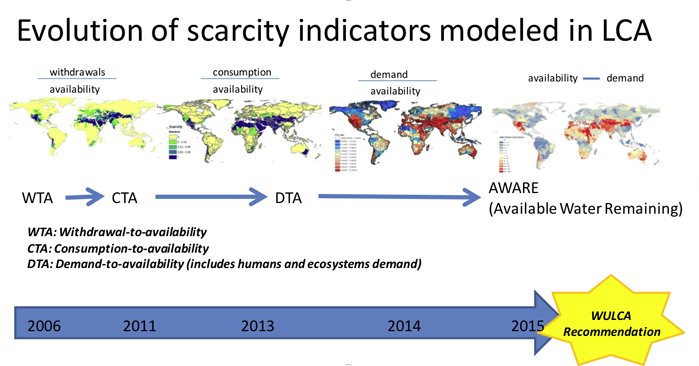The WULCA working group’s overall goal focuses on providing practitioners, from both industry and academia, with a consensual and consistent framework to assess, compare and disclose the environmental performance of products and operations regarding freshwater use. In addition to create a discussion platform that boosted the scientific research around water use in LCA, WULCA significantly influenced the creation of the draft standard ISO DIS 14046 on water footprinting: five members of WULCA, including the convener, were directly involved as national representatives within the ISO process. The main scientific WULCA deliverables are listed here.
The objective of this specific project conducted within WULCA working group was therefore to coordinate the consensuses building process and lead the scientific work into achieving a harmonized method for assessing water use in LCA, involving key method developers and stakeholders through an international collaborative effort. This consensus building process resulted in the AWARE methodology described in this section. All other AWARE-related developments (non-marginal AWARE factors, sector-specific AWARE and Regionally adapted factors) did not follow such process.
In May 2013, WULCA received the mandate from the UNEP SETAC Life Cycle Initiative (Project on Global Guidance on Environmental life cycle impact assessment indicators) to lead the harmonization and consensus building for the water use impact category.
The objective of this specific project conducted within WULCA working group was therefore to coordinate the consensuses building process and lead the scientific work into achieving a harmonized method for assessing water use in LCA, involving key method developers and stakeholders through an international collaborative effort.
Preliminary discussions within this working group identified the relevant question from an LCA perspective regarding potential impacts of water consumption at the midpoint level to be: “What is the potential to deprive another freshwater user (human or ecosystem) by consuming freshwater in this region?” (Boulay et al, Int.JLCA, 2015).
Outcomes from expert discussions within WULCA first identified the need to transition from WTA and CTA towards a demand-to-availability ratio (DTA), in order to better answer the overarching question since both ecosystem water demand and human consumption are considered in “demand”. The proposal was accepted by a panel of 48 LCA experts from academia, industry and governmental institutions during three international expert workshops held in Zurich, San Francisco and Tzukuba in 2014. One main limitation identified, in addition to the challenge associated with quantifying ecosystem water demand was that the DTA ratio (similarly to CTA and WTA) fails to represent the absolute water availability (per unit of surface). It only focuses on a metric relative to the use, resulting in loss of information. For example, a DTA ratio of 0.5 describes that half of the water is required by current users, but whether this amount of water is 10 or 1 000 000 m3 for the same area, is unknown. This sometimes leads to arid areas showing less scarcity than known water-abundant regions and the relevance of this for LCA application can be questionable. Three proposals emerged during the workshops that could overcome this limitation: DTAA, DTAx, and 1/AMD.
The process first used a pre-selection criterion to evaluate the relevance of each indicator with respect to the question to be answered. Non relevant indicators were filtered out from the second step (DTAA). Second, a set of criteria were used to guide the decision leading to the selection of 1/AMD through consensus, which is the basis for the recommended AWARE method.
